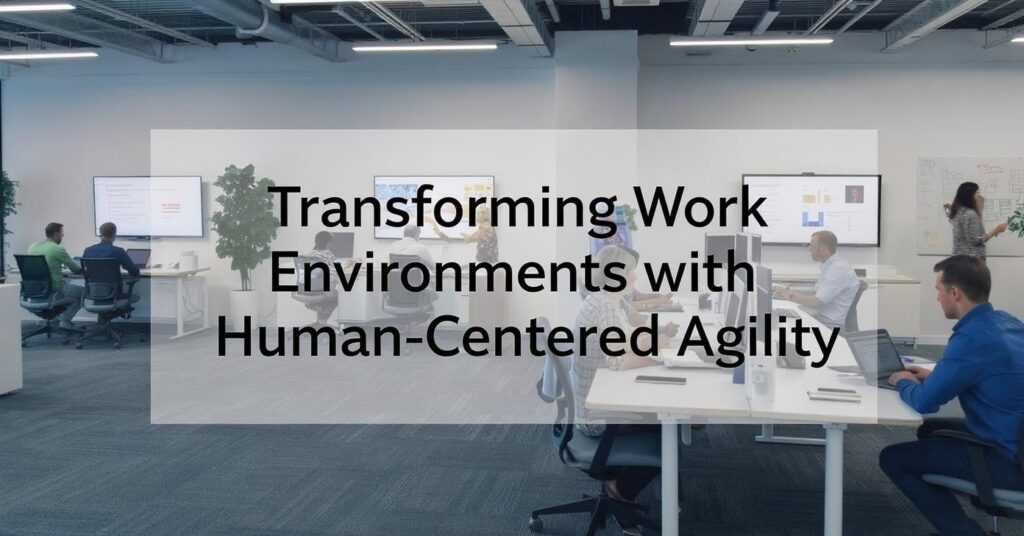In today’s rapidly evolving business world, companies are under constant pressure to innovate, respond quickly to market shifts, and maintain a competitive edge. Agility is the key to success in this environment, but many organizations mistakenly view agility as solely a matter of tools, technologies, or processes. The truth is, workplace agility begins with human-centered culture. It is the people—their mindset, motivation, and engagement—that determine whether an organization can be truly agile.
At Bizinfopro, we believe that Human-Centered Culture forms the foundation of agile workplaces. Companies that prioritize empathy, trust, collaboration, and employee well-being are more responsive to change and resilient in the face of uncertainty. Let’s explore how a people-first approach fosters workplace agility and why it is critical for future-ready businesses.
Understanding Workplace Agility in the Modern Era
Workplace agility refers to an organization’s ability to respond to disruptions, opportunities, and evolving market demands with speed and effectiveness. It means being able to pivot quickly, adopt new strategies, and empower teams to make decisions on the fly. However, agility does not emerge from rigid frameworks or constant restructuring—it thrives in cultures where people feel empowered and supported.
This is exactly why workplace agility begins with human-centered culture. A culture that values the human experience at work—emphasizing empathy, inclusivity, autonomy, and psychological safety—creates the right conditions for agility to flourish. When employees are motivated, trusted, and aligned with organizational goals, they are more willing to adapt and contribute during periods of change.
The Human Element: Why It Matters More Than Ever
In traditional organizations, decisions are often top-down, and change initiatives are rolled out without involving those on the ground. This leads to resistance, disengagement, and even burnout. Agile organizations, in contrast, recognize that employees must be active participants in shaping the future of work. A human-centered culture builds agility by giving people the voice, tools, and trust they need to adapt and innovate.
Organizations that understand why workplace agility begins with human-centered culture are those that treat employees not just as workers, but as partners. They foster open communication, offer flexible work models, and empower individuals to take ownership of their roles and responsibilities.
Empowering Employees to Make Agile Decisions
Agility is closely tied to decision-making. In rigid organizations, decisions often get delayed due to hierarchy and bureaucracy. In agile environments, decisions are made closer to the action—by the teams and individuals best equipped to respond quickly.
Empowering employees requires a shift in mindset. It means trusting people to make choices, encouraging experimentation, and allowing room for failure and learning. A human-centered culture removes the fear of making mistakes and promotes continuous improvement. This autonomy fosters accountability, initiative, and ultimately, agility.
Leadership That Supports Human-Centered Agility
Leadership is crucial in creating and sustaining a human-centered culture. Agile leaders focus less on control and more on enabling others. They lead with empathy, model transparency, and create conditions where employees feel heard, respected, and psychologically safe.
Such leaders:
Encourage collaboration across departments
Provide regular, meaningful feedback
Recognize and celebrate contributions
Embrace change as a shared journey
When leaders embody human-centered values, they reinforce the idea that workplace agility begins with human-centered culture, creating a ripple effect across the organization.
Psychological Safety as a Cornerstone of Agility
One of the most important aspects of human-centered culture is psychological safety—the belief that one can speak up, take risks, and be vulnerable without fear of blame or punishment. Psychological safety is essential for innovation, collaboration, and agility.
In psychologically safe workplaces:
Team members feel confident sharing ideas
Mistakes are viewed as learning opportunities
Diverse perspectives are welcomed and valued
Change is embraced rather than feared
Organizations that foster psychological safety empower employees to respond quickly to change, make informed decisions, and continuously learn—key traits of agile workforces.
Flexibility, Autonomy, and Work-Life Integration
Agile organizations understand that employees are more than their roles. They are individuals with personal needs, goals, and challenges. A human-centered culture promotes work-life integration, offering flexibility in how, when, and where people work.
Whether through hybrid work models, flexible schedules, or supportive policies, organizations that prioritize employee well-being are more likely to retain talent and encourage innovation. This flexibility also prepares teams to navigate change without disruption, reinforcing why workplace agility begins with human-centered culture.
Fostering a Culture of Continuous Learning
In a rapidly changing business landscape, learning is not a one-time event but a continuous journey. Agile organizations embed learning into their culture, offering opportunities for employees to grow, reskill, and take on new challenges.
Human-centered learning environments provide:
On-demand access to training resources
Encouragement to experiment and fail forward
Opportunities for cross-functional collaboration
Supportive mentorship and coaching
When learning is prioritized, employees become more adaptable and confident, strengthening the organization’s overall agility.
Diversity, Equity, and Inclusion (DEI) as Agility Drivers
Diverse teams are inherently more agile. They bring different viewpoints, cultural insights, and problem-solving approaches that enhance creativity and adaptability. However, diversity alone isn’t enough. Inclusion ensures that every voice is heard and valued.
A human-centered culture promotes equity and inclusion by:
Implementing fair hiring and promotion practices
Providing bias training and inclusive leadership development
Supporting Employee Resource Groups (ERGs)
Creating safe spaces for dialogue and feedback
Organizations that champion DEI build resilient, innovative teams that are better equipped to respond to change—another reason why workplace agility begins with human-centered culture.
Technology Adoption with a Human Touch
While digital tools and automation are essential to modern agility, their effectiveness depends on how they’re implemented. A human-centered approach ensures that technology is designed around the needs of users—not the other way around.
This involves:
Involving employees in technology decisions
Providing adequate training and support
Prioritizing user experience and accessibility
Continuously gathering feedback for improvement
When technology empowers rather than burdens employees, it drives collaboration, productivity, and agility at every level.
Cross-Functional Collaboration and Agile Networks
Siloed departments are one of the biggest barriers to agility. A human-centered culture breaks down these silos by encouraging collaboration, knowledge sharing, and transparency.
Cross-functional teams:
Solve complex problems more effectively
Adapt to challenges with combined strengths
Foster trust and accountability
Create more aligned and strategic outcomes
Agility is not confined to one department—it must flow across the entire organization. When collaboration becomes a cultural norm, responsiveness and resilience become second nature.
Realizing the Benefits of Human-Centered Agility
Organizations that invest in building a human-centered culture report higher employee engagement, lower turnover, and faster time-to-innovation. They are more responsive to customer needs, better equipped for disruption, and more capable of sustaining long-term growth.
At Bizinfopro, we help organizations unlock this potential by aligning culture, leadership, and employee experience with agile principles. Our approach centers on the belief that people are the driving force behind successful transformation.
Why workplace agility begins with human-centered culture is not just a philosophy—it is a proven strategy for thriving in the modern business world.
Read Full Article : https://bizinfopro.com/blogs/hr-blogs/why-workplace-agility-begins-with-human-centered-culture/
About Us : BizInfoPro is a modern business publication designed to inform, inspire, and empower decision-makers, entrepreneurs, and forward-thinking professionals. With a focus on practical insights and in‑depth analysis, it explores the evolving landscape of global business—covering emerging markets, industry innovations, strategic growth opportunities, and actionable content that supports smarter decision‑making.



